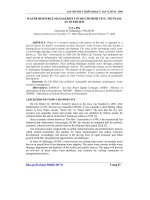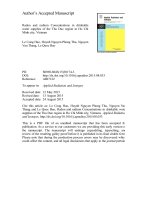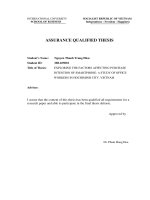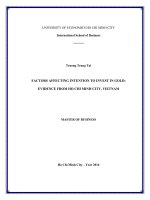The effect of conflict to social loafing in group work of organization research in ho chi minh city, vietnam
Bạn đang xem bản rút gọn của tài liệu. Xem và tải ngay bản đầy đủ của tài liệu tại đây (155.81 KB, 12 trang )
The Effect Of Conflict to Social Loafing in Group Work of
Organization - Research in Ho Chi Minh City, Vietnam
Vu Ba Thanh
Food Farm Company Limited., Vietnam
Ngo Van Toan
University of Finance – Marketing, Vietnam
Abstract
This study explores the impact of conflicts on social loafing in the organization's group work.
Through
quantitative analysis of the survey data for 457 civil servants working in Ho Chi Minh city to evaluate
the scale
and research model. Research results show that the three components of conflict: task conflict,
relationship
conflicts, and process conflict have the same effect on the social loafing of the individual in the
group. The
results also show that conflicting relationships will have the greatest impact on social loafing.
Therefore, each
organization should take measures to reduce social loafing in order to reduce the uncertainty of
members in
the process of group work.
Keywords: Social loafing, Conflict, Group work, Ho Chi Minh City.
1. Introduction
In the life of the human working group is indispensable. According to Karau & Williams
(1993), we join teams to perform many important tasks that require collective effort to work
together to address the ultimate goal of organization set. Group activity is not limited to any
field and in any area requires team existence and teamwork is essential. As Poole et al. (2004)
stated that "people live in groups, work in groups, and play in groups." However, when working
in groups, the conflict between members is unavoidable. According to Tuckman (1965), a
conflict is a place that will explain the discovery of social loafing among individuals in that
community. Although teamwork is highly recommended, social loafing in the group should not
be ignored, social loafing will reduce the effectiveness of the group (Latane et al., 1979). Thus,
the conflict in the collective will take place and then what will the members of the rest of the
way? Understanding the importance of collective conflict and social loafing among individuals
in the organization, the authors explore the impact of conflicts on social loafing in this study.
2. Theoretical background and research model
Conflict
Group work in the organization is a "tool" for us to feel the disturbance in the group. Conflict
arises when team members are not aware of a common goal and the interventions of each
member to achieve that goal are different (Singh et al., 2017). Conflict is likely to make the
group members' cohesion less likely, and group cohesion will also decrease if the conflicts
between members are large (Jehn, 1995).
787
Conflicts identified by researchers consisted of three components: task conflicts, relationship
conflicts and process conflicts (Jehn, 1997; Jehn & Mannix, 2001). Task conflicts are defined as
disagreements and arguments among team members about the content of the work and the goals
to be achieved, or arguments about the merits of a problem in the team (Behfar et al., 2011; De
Dreu & Weingart, 2003; Jenn, 1995, 1997; Priem & Price, 1991). When a conflict of interest is
moderate, it helps the team members to better understand the goals and will help them get more
ideas. As a result, the group will be more efficient and the productivity of the group will be increased
(Amason, 1996; Jehn, 1995; Schweiger, Sandberg & Rechner, 1989; Cozier & Rose, 1977). In
addition, if high-level task conflicts in the group result in more individual conservatism with their
proposals, the effectiveness of the group will deteriorate and the quality of the termination
Relationships among members are also reduced (DeChurch, Hamilton, & Haas, 2007; Tidd, McIntyre
& Friedman, 2004; Simons & Peterson, 2000). Conflict is a social conflict or emotional conflict that
arises from differences in the value and personality of each individual. In addition, conflict in
relationships is often influenced by hostility, tension and discomfort among team members (Behfar
et al., 2011; De Dreu & Weingart, 2003; Pearson, Ensley & Amason, Jenn, 1995, 1997; Priem & Price,
1991). Relationships have a negative impact on group productivity and job satisfaction (Wall &
Nolan, 1986). Process conflict is the disagreement about how best to mix resources from group
work, including time issues and workload distribution (Janicik & Bartel, 2003). Process conflicts can
reduce the efficiency of the team as well as the ability to coordinate tasks in the most efficient way
(Deutsch, 1973; Jehn
& Chatman, 2000). In addition, process conflicts can negatively affect the satisfaction of
members when working together by causing feelings of disrespect and unfairness in the group
(Lind & Tyler, 1988). These three types of conflicts not only affect the performance and
satisfaction of the group, but also these three types of conflicts are interrelated throughout the
working group. Jehn's (1997) study has proven that conflicts of interest can be transformed into
conflicting relationships when criticisms regarding task performance are considered negative or
unresolved tasks. Successful. Research by Behfar et al. (2008) also suggests that process
conflicts will reach a higher level than all other types of conflict in group interaction.
Social Loafing
The origin of social loafing began with researcher Ringelmann (1913, led by Latané et al.,
1979; Simms, 2014), who experimented with participants in pulling a rope when the
participants pull the rope, they work less and their pull is lower when they do it alone. As the
size increases, the performance in the group is lower than that of an individual performing the
same job. From the above observations, Ringelmann pointed out that when working in groups,
the individual's effort would decrease. So, these effects are called the "Ringelmann effect"
(Latané et al., 1979). After discovering the "Ringelmann Effect," many researchers have come
up with statements for this effect. Steiner (1972), led by Singh (2017), proposed two
explanations to explain the Ringelmann effect: One is individuals without motivation to pull the
rope or by those who lack motivation. Reduce effort, especially when group size increases. The
second explanation is that the team may not work together so that the efforts of the members
are not optimal. Ingham, Levinger, Graves, and Peckham (1974) repeated the rope spinning
experiment. In this experiment, researchers asked participants to blind their eyes to pull the
rope and make the test takers believe they were pulling the rope along with others, while in
fact, They have to do it alone. And the results have shown that the individual's performance is
still lower than when they know they will perform alone. Williams & et al (1981) expanded the
experiment and came to the conclusion that if the efforts of the individuals in the organization
were measured, those who caused conflict or cause indifference would decrease and Their
research focuses on the study of how to measure the output of individuals in the organization.
With Ingham et al. (1974) and Latane et al. (1979), there are many other authors who have
followed Karau et al. (1993); George (1992); Etemadi et al. (2015) argue that collective
resilience is a phenomenon where the individual's efforts to achieve a goal when they work in a
team are lower when the individual works independently.
788
The relationship between conflict and social loafing
Social loafing is directly provoked by the conflict between individuals because the
perception of unfair work and the distribution of unfair rewards is where social loafing begins.
Negative influences caused by conflict among team members can be lengthened, leaving
members to remain indifferent to the work that needs to be done within the group (Öhman,
Flykt, & Esteves, 2001)
In addition, social loafing also comes directly or indirectly from conflicting relationships.
Direct engagement of individuals within the group can be initiated by arguing to withdraw from
this conflict and may at least reduce one's contribution to the group (i.e. two basic factors
determining collective ignorance). Although withdrawing from the conflict of relationships and
reducing efforts in the group does not mean that support for collective redundancy occurs, the
issue is also considered to have negative effects on productivity and group spirit (Deutsch,
1973). Baxter (1982) likewise argues that avoiding conflicting relationships is a common means
of dealing with conflict within the group. Team members are quite alert and sensitive to those
who tend to avoid and work to reduce conflict within the group because they do not want to be
unfairly judged by potential lazy people. conflicting relationship. At the same time, relationship
conflict can also affect collective neutrality through reconciliation (Jehn, 1997). Based on the
above analysis of the relationship between collective indifference, conflict of relations, it can be
seen that both conflict and conflict can directly cause collective indifference in the group.
The relationship between task conflicts and process with collective ignorance may depend
on the level of negative emotions in the group. Research has shown that groups discuss and
discuss issues of goals or tasks when confronted with each other at a moderate level of work
(Jehn, 1995). These conflicting interactions show the motivation of team members to
reorganize the group's resource structure by assigning the right job to the right person. They
can also minimize collective negligence because group members believe that their involvement
in resolving tasks or conflicting processes is meaningful and important to achieving personal
goals. as well as the group (Karau and Williams, 1993)
From the above discussion, the authors propose the following research model
Task conflict (TC)
Relationship conflict (RC)
Process conflict (PC)
Model: The model aims to examine the factors that affect organizational equality
SL 1*TC 2 *RC 3 *PC
3. Research methodology
Research using qualitative-quantitative research method. The qualitative method is used to
find the scale that matches the model and then uses a quantitative method to verify that the
model is appropriate. The data was collected from staff working at organizations in Ho Chi Minh
City through convenient sampling.
789
The data collection tool consists of 3 parts. First, the tool includes demographic questions
designed to determine the age, gender, location, the time they work at the organization and
find out if they are part of a team. or not. In the second part, 18 questions are designed to
measure the composition of conflict elements in an organization. And finally, the third part is
the 10 questions that are designed to measure organizational ignorance. These scales are used
on the Likert scale of 5 levels from level 1 to "completely disagree" to level 5 as "absolutely
agree". The number of participants in this study was 457.
4. Analysis of data and results
Cronbach’s Alpha and Exploratory Factor Analysis
Verification of Cronbach's Alpha scale reliability showed that four observation variables of process
conflict (PC), 3 observation variables of task conflict variable (TC), 3 variable observation variables
(RC), and 8 observable variables in 10 variables of collective barometric variability (SL) (observed
variables SL3 and SL7 with index less than 0.3 should be excluded) have the reliability High
dependence (greater than 0.6), these independent variables will be included for EFA analysis for the
next step. After performing EFA as shown in Table 1, the KMO = 0.751> 0.6 indicates that the results
of the EFA analysis are reliable and that the analysis is appropriate. Sig value. = 0.000 ≤ 0.05 in the
Battle test showed that the analysis results were statistically significantly greater than 95% and the
observed variables were correlated in the overall. The total variance of 63.802% representing the
factors derived from the analysis can account for 63.802% of the variation in the initial survey data.
The coefficient of Eigenvalues of the four factors in the model is equal to 1,835> 1, confirming that
there will be three factors derived from the analysis and the factor load factor of the observed
variables in each factor of the variables. Observations in each factor are greater than 0.5 showing
the good representation of the variables for the factor that the variables represent. The results in
Table 1 also show that factors that represent research concepts and are highly reliable are well
suited for subsequent analyzes.
Bảng 1: Results of Cronbach’s Alpha and EFA
Variable
PC1
PC4
PC2
PC3
TC3
TC1
TC2
RC1
RC2
RC3
SL10
SL9
SL8
SL1
SL6
SL5
790
SL2
SL4
Invalid method
Eigenvalues
KMO = 0,751
Regression results
The authors performed regression analysis with SL dependent variables and three
independent variables, TC, RC and PC. Results are presented in Table 2
Table 2: Results of regression analysis
Model
(Hằng số)
Task Conflict (TC)
Relationship Conflict
1
(RC)
Process Conflict (PC)
a. Biến phụ thuộc: Social Loafing (SL)
R2 = 0,546 ; Adj R2 = 0,543
F = 181,030; Sig. = 0,000
From the regression result of Table 2, the R2 coefficient is 0.546 and the R2 correction is
0.543. Thus, the model with 3 task conflict variables (TCs), conflict relationships (RC) and
process conflicts (PC) accounted for 54.3% of the impact of conflicting components collective
indifference in the group. Sig value = 0.000 (<0.05), so the combination of two independent
variables can explain the variability of the dependent variable. The magnified coefficients of
the VIF variance (Table 2) are less than 2, indicating that the regression model does not occur
in multi-collinear phenomena (when VIF exceeds 10, multipliers occur and when VIF is greater
than 2, it is necessary to be careful in interpreting the regression weights.
Regression analysis gives us the normalized linear regression equation as follows
OJ 0.345*TC 0.377* RC 0.321* PC
Through the above equation,
same effect on the behavior of
equation on the components of
internal communication factor
organization with 0.321
it can be seen that the TC, RC and PC components have
card issuers of organizations in Ho Chi Minh City. From
conflicts, the levels of impact are nearly the same, but
has the lowest impact on collective indifference in
the
the
the
the
5. Conclusion
Research results show that the components of collective conflicts, such as conflicts of interest,
conflicts of relationships and process conflicts, have the same impact on collective indifference at
the organizations in HCMC. Ho Chi Minh City with a representative sample of 457 samples. In
particular, conflicting relationships
791
are most strongly influenced by the collective consciousness, followed by conflicts of interest and
conflicts that have the least effect on collective ignorance. The study by Simon and Peterson (2000)
also showed that conflicts of duty would turn into conflicts of relationships when resource allocation
to solve problems was wrong. This demonstrates that in order to stimulate creativity and increase
efficiency, a reduction in task conflicts is needed and that team members will understand more
about the tasks that need to be done in the team (Jehn, 1995; Simons & Peterson, 2000). Therefore,
in order to reduce collective negligence, members of the organization should also avoid possible
conflicts when working together. In order to minimize conflicts that may occur during group work,
members need to have agreements, rules, or standards to manage conflicts while performing group
tasks. In addition, the performance of tasks to achieve the objectives of the work, the members also
need to clearly assign responsibilities and rights of each member when performing tasks in the
group. In addition, when assigning tasks to each member, they should be assigned fairly and
appropriately so that every member of the team understands that the assignment is appropriate to
their abilities and believes that success The group's contribution is due to the contribution of that
member's effort. Finally, in the event of a conflict, discussions, and discussions need to be limited to
finding mistakes or mistakes in the group process rather than the individual's failure to do so. For
greater conflict between individuals. From the above suggestions, collective redundancy will be
reduced in the event of a conflict, and in conflicting group operations, conflict resolution will be
effective. Reduce the team and make the team work better
However, research is limited to the relationship between conflict and social loafing, so more
research is needed to find out how other components affect social loafing. In addition, nonprobability sampling in some central districts may make the sample less representative, so this is
another direction to improve the sampling method. In addition, the differences of the surveyed
subjects such as age, sex, education level, job position ...
also affected the social loafing. And one suggestion for further research is that further research
is needed in a specific industry so that it is possible to identify which sector factors have a
strong impact on social loafing.
References
Behfar, K. J., Mannix, E. A., Peterson, R. S., & Trochim, W, M. (2011). Conflict in small groups: The meaning and
consequences of process conflict. Small Group Research, 42, 127-176.
Behfar, K., Peterson, R., Mannix, E., & Trochim, W. (2008). The critical role of conflict resolution in teams: A close look at
the links between conflict type, conflict management strategies, and team outcomes. Journal of Applied Psychology,
93, 170-188
Cosier, R., & Rose, G. (1977). Cognitive conflict and goal conflict effects on task performance. Organizational Behavior
and Human Performance, 19, 378-391.
De Dreu, C. K. W., & Weingart, L. R. (2003). Task versus relationship conflict, team performance, and team member
satisfaction: A meta-analysis. Journal of Applied Psychology, 88, 741–749.
DeChurch, L. A., Hamilton, K. L., & Haas, C. (2007). Effects of conflict management strategies on perceptions of
intragroup conflict. Group Dynamics: Theory, Research, and Practice, 11, 66-78.
Deutsch, M. (1973). The resolution of conflict: Constructive and destructive processes. New Haven, CT: Yale Press.
Etemadi, M., Darab, M. G., Khorasani, E., Moradi, F., & Vazirinasab, H. (2015). Social loafing among nurses and its
relation with organizational justice. International Journal of Educational and Psychological Researches, 1(2), 125-130
George, J. M. (1992). Extrinsic and intrinsic origins of perceived social loafing in organizations. Academy of
Management Journal, 35, 191– 202.
Greer, L. L., & Jehn, K. A. (2007). The pivotal role of negative affect in understanding the effects of process conflict on
group performance. In E. A. Mannix, M. A. Neale, & C. P. Anderson (Eds.). Research on managing groups and teams (
Vol. 10, pp. 21-43). Greenwich, CT: JAI Press
Guetzkow, H. & Gyr, J. (1954). An analysis of conflict in decision-making groups. Human Relations, 7, 367-381
Ingham, A. G., Levinger, G., Graves, J., & Peckham, V. (1974). The Ringelmann effect: Studies of group size and group
performance. Journal of Experimental Social Psychology, 10(4), 371-384
Janicik, G., & Bartel, C. (2003). Talking about time: Effects of temporal planning and time awareness norms on group
coordination and
performance. Group Dynamics: Theory, Research, and Practice, 7, 122-134. doi:10.1037/1089-2699. 7.2.122
Jehn, K. A. (1995). A multimethod examination of the benefits and detriments of intragroup conflict. Administrative
Science Quarterly, 40, 256-282
Jehn, K. A. (1997). Qualitative analysis of conflict types and dimensions in organizational groups. Administrative
Science Quarterly, 42, 530-557.
Jehn, K. A., & Mannix, E. A. (2001). The dynamic nature of conflict: A longitudinal study of intragroup conflict and group
performance.
Academy of Management Journal, 44, 238–251.
Jehn, K., & Chatman, J. (2000). The influence of proportional and perceptual conflict composition on team performance.
International Journal of Conflict Management, 11, 56-73.
792
Karau, S. J., & Williams, K. D. (1993). Social loafing: A meta-analytic review and theoretical integration. Journal of
Personality and Social Psychology, 65, 681-706.
Latané, B.,Williams, K., & Harkins, S. (1979). Many hands make light the work: The causes and consequences of social
loafing. Journal of Personality and Social Psychology, 37, 822-832.
Lind, A., & Tyler, T. (1988). The social psychology of procedural justice. New York, NY: Plenum Press.
Öhman, A., Flykt, A., & Esteves, F. (2001). Emotion drives attention: Detecting the snake in the grass. Journal of
Experimental Psychology:
General, 130, 466–478
Pearson, A. W., Ensley, M. D., & Amason, A. C. (2002). An assessment and refinement of Jehn’s Intragroup Conflict
Scale. The International Journal of Conflict Management, 13, 110-126.
Poole, M. S., Hollingshead, A. B., McGrath, J. E., Moreland, R. L., & Rohrbaugh, J. (2004). Interdisciplinary perspectives
on small groups.
Small Group Research, 35, 3–16.
Priem, R., & Price, K. (1991). Process and outcome expectations for the dialectical inquiry, devil's advocacy, and
consensus techniques of strategic decision making. Group and Organization Studies, 16, 206-225
Schweiger, D., Sandberg, W. & Rechner, P. (1989). Experiential effects of dialectical inquiry, devil's advocacy, and
consensus approaches to strategic decision making. Academy of Management Journal, 32, 745-772.
Simons, T., & Peterson, R. (2000). Task conflict and relationship conflict in top management teams: The pivotal role of
intragroup trust.
Journal of Applied Psychology, 83, 102-111.
Singh, S., Wang, H., & Zhu, M. (2017). Perceptions of Social Loafing in Groups: Role of Conflict and Emotions.
Tidd, S. T., McIntyre, H. H., & Friedman, R. A. (2004). The importance of role ambiguity and trust in conflict perception:
Unpacking the task to relationship conflict linkage. International Journal of Conflict Management, 15, 364-380.
Tuckman, B.W. (1965). Developmental sequences in small groups. Psychological Bulletin, 63, 384-399
Wall, V., & Nolan, L. (1986) Perceptions of inequity, satisfaction, and conflict in task-oriented groups. Human Relations,
39, 1033-1052.
793









